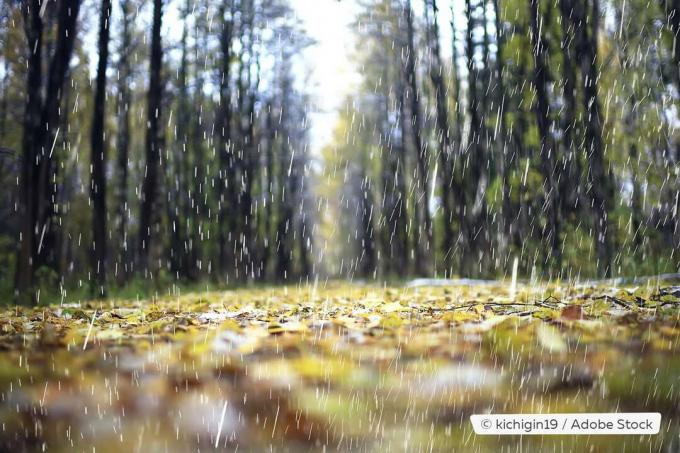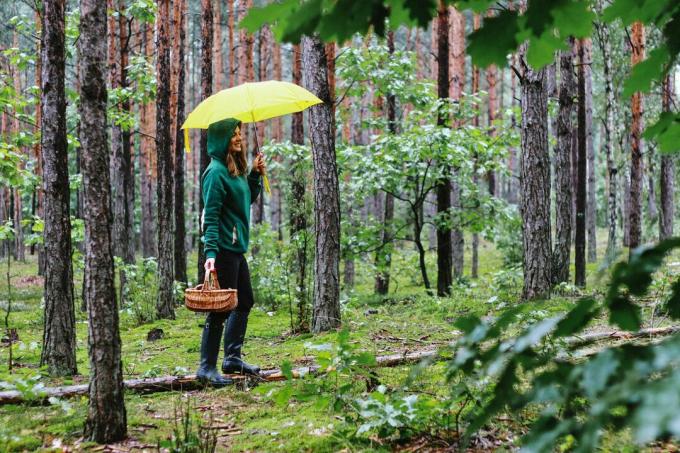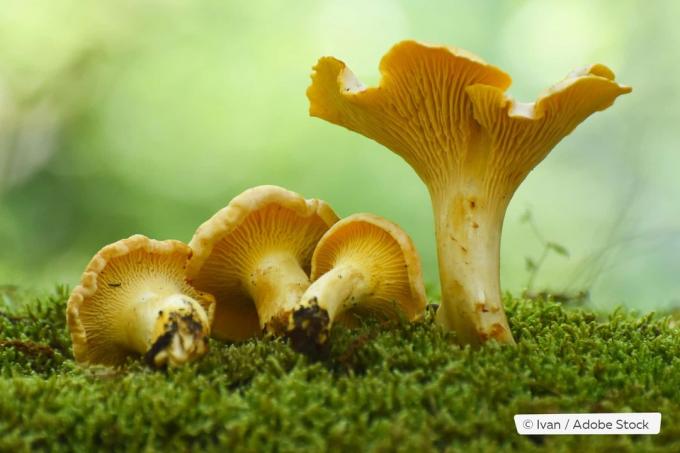
Is it actually true that a rainy summer promises a rich mushroom harvest in autumn? We'll tell you what this myth is all about and explore the question of when mushrooms grow after the rain.
To the point
- Moisture is essential for fungal growth
- set off one to two weeks after rain
- Growth takes a few days
- do not collect when it rains
- wet mushrooms spoil more quickly
Table of contents
- Ideal mushroom weather
- Do not collect when it rains
- Optimal collection time
- frequently asked Questions
Ideal mushroom weather
There is actually something to the old collector's wisdom that a rainy summer causes mushrooms to sprout: mushrooms need a lot of moisture to grow. Changeable and warm weather with cool nights is optimal for the delicious forest fruits - that is also the reason which is why you will find most edible mushrooms in the fall between August and October. However, it doesn't have to rain consistently for weeks, because a certain level of basic moisture (for example from an occasional downpour or morning dew) is sufficient.

But even after a heavy rain, you don't have to start running straight away, because
- Mushrooms only grow approx. one to two weeks after the rain
- A downpour is not sufficient after a long dry period
- Forest soil must be well moistened, i.e. H. it should have rained more often or for longer
Tip: Tasty edible mushrooms can be found not only in warm, changeable weather. Oyster mushrooms, for example, only grow at temperatures of less than eleven degrees Celsius and can therefore even be collected in the cold winter.
Do not collect when it rains
But be careful, collect Forest mushrooms definitely not in the rain! It's better to wait until the sun comes out again and warms the ground a little. Because
- Rain-damp mushrooms spoil very quickly
- They swell quickly and then lose their taste
- be of snails and other animals eaten
- Not only do they need moisture to grow, they also need sun

It is therefore best to draw approx. a week after the rain and in dry weather we went into the forest with a basket and knife, because then the mushrooms had enough time to grow. After a few days you can repeat this tour again and you will definitely find what you are looking for.
Tip: Take a small hand mirror with you into the forest. This means you can look under the mushroom caps to see whether they are infested with maggots without having to cut the mushrooms off. In this way, you can let infected mushrooms stand and mature so that their spores ensure a rich harvest in the coming years.
Optimal collection time
Mushrooms actually grow overnight, which is why you should start collecting as early as possible in the morning. Then there is also less risk that snails, maggots and other hungry forest dwellers will have eaten their fill - these often only become active during the daylight hours. when the mushrooms are older. Young specimens, however, are rarely affected and they also taste better. Otherwise, forest mushrooms can be collected not only in late summer and autumn, but all year round:

- Spring: Spring Mürbling, May Mushroom, Morel Becherling, Giant bovist, Scaly Porling, pointed morels and morels, Verpel
- Summer: Birch mushroom, butter mushroom, aspen red cap, pearl mushroom, chanterelle, summer boletus, red-footed mushroom, Meadow mushroom
- Autumn: honey mushroom, autumn trumpet, Chestnut, chanterelle, mushroom, stick sponge, smoke-leaved sulfur head
- Winter: Oyster mushroom, frost snail, Judas ear, velvet foot mushroom
A notice: Many of the summer and autumn mushrooms listed can be found from May to October/November, other species such as Judas' ear even grow almost all year round.
frequently asked Questions
Most types of mushrooms grow quite quickly and only take a few days to reach a size that the mushroom picker likes. Only porcini mushrooms grow comparatively slowly, which is why it is recommended that you go into the forest about one to two weeks after the rain. However, you shouldn't wait too long, as large and old specimens usually no longer taste as good.
In general, the guideline is not to collect more than for your own home use: As a rule, this should be a maximum of one to two kilograms of mushrooms that you can take out of the forest. However, a specific collection amount is not set by law and is therefore at the discretion of law enforcement.
Look for areas that are rich in moss and lichen and where it is not too dark. These plants are safe fungal indicators. Depending on the type of mushroom you are hoping for, make sure you choose the right trees – Porcini mushrooms about is usually found near Book or Oaks. On the other hand, grow Blackberries, balsam, Nettles and other indicators of high nutrient content in the soil, you will not find any mushrooms there - even in heavily managed forests.



